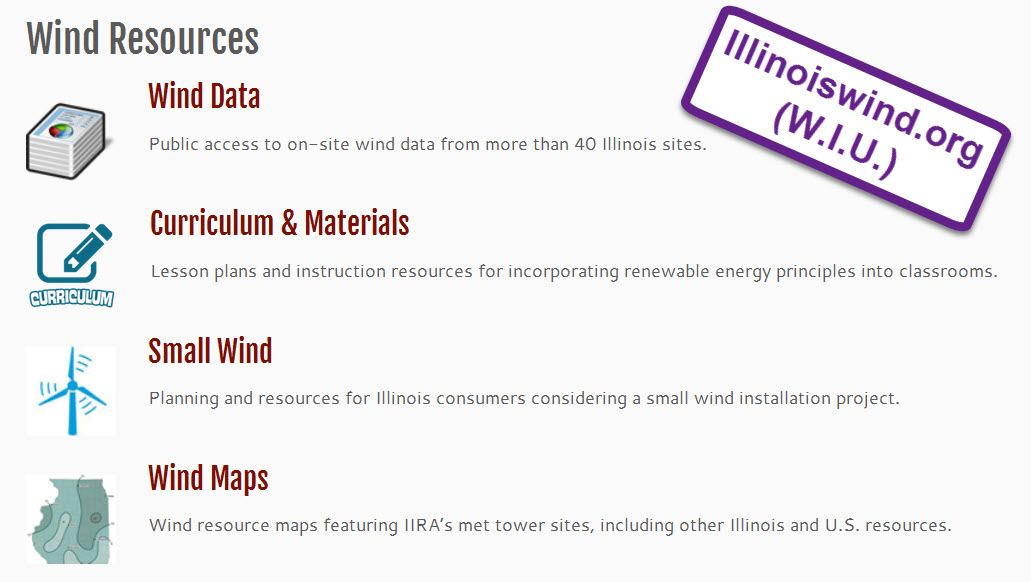

I'm a math educator, but have become involved and interested in wind energy, wind energy curriculum, and the associated Next Generation Science Standards (NGSS). #STEM This page provides me (and I hope you) basic information and links to more information.
Furthermore, I have been part of a team of five teacher educators who have put together a K-12 curriculum of 12 lessons titled, STEM Through a Wind Turbine. The curriculum is now available and is provided below.
Illinois Wind - http://www.illinoiswind.org/ - Illinois Wind site from the Illinois Institute for Rural Affairs at Western Illinois University
- Wind resource data (in Illinois taken using met [meteorological] towers); Curriculum & Materials; Small Wind (info); Wind Maps; Wind (Utility-Scale) Project Maps.
Illinois Clean Energy Community Foundation - http://www.illinoiscleanenergy.org/ -
- They provide grants to support the installation of 1-5 kiloWatt wind turbines throughout Illinois at K-12 school ("up to $40,000 or 90% of the system and its installation costs, whichever is less").
ISU Center for Renewable Energy - http://renewableenergy.illinoisstate.edu/ - Illinois State University
- Extensive report on the Economic Impact of Illinois Wind Energy, curriculum, and Illinois Wind Working Group. Table 2 of the report has information about electrical companies harvesting wind and number of utility-scale turbines in use (100's).
Wind for Schools Portal - http://en.openei.org/wiki/Wind_for_Schools_Portal - OpenEI (Open Energy Information) site
- Operational data from small wind turbines installed at K-12 schools in 12 states (and one can compare); Curricula and Education Resources; Funding ideas of school wind turbine projects; Careers.
Kid Wind Project - http://www.kidwind.org/ They sell wind kits, have curriculum materials, and they have a KidWind Challenge.
Educational Resources from NREL - http://www.nrel.gov/education/educational_resources.html - NREL = National Renewable Energy Lab (US Dept. of Energy)
- Provides educational resources for elementary through high school on renewable resources (not just wind).
Wind Exchange - http://apps2.eere.energy.gov/wind/windexchange/ - from the US Dept. of Energy (DOE)
- Big picture: U.S. DOE Wind Program's platform for disseminating credible information about wind energy.
Wind Energy Basics - http://windeis.anl.gov/guide/basics/ - Wind Energy Development Programmatic Environmental Impact Statement (EIS) is from the U.S. Dept. of the Interior Bureau of Land Management with assistance from Argonne National Laboratory (Argonne).
- Provides basic information and concepts on wind energy and wind turbines.
National KidWind Challenge - https://www.kidwindchallenge.org/nationals
- Annual wind energy conference with a competition and prize money.
Main Next Generation Science Standards site - http://www.nextgenscience.org/
There are Three Dimensions: Practices, Crosscutting Concepts (CCC), and Disciplinary Core Ideas (DCI's)
Disciplinary ideas are grouped in four domains: the physical sciences (PS); the life sciences (LS); the earth and space sciences (ESS); and engineering, technology and applications of science (ETS).
How to Read the Next Generation Science Standards - http://www.nextgenscience.org/resources/how-read-next-generation-science-standards
List of Common Acronyms used by NGSS (PE = Performance Expectation and more!)
In 2016, a group of teacher educators at Western Illinois University developed a wind curriculum, for use in K-12 schools.
Click here for the FULL CURRICULUM.
We were supported by a Wind for Schools grant which was awarded to the Illinois Institute for Rural Affairs (IIRA) from the National Renewable Energy Laboratory (NREL).
We presented information about the curriculum at the Illinois Math and Science (ICTM/ISTA) Conference on Oct. 7, 2016 (at which point the curriculum was not yet fully complete). Here is the PowerPoint.
Drs. Abha Singh and Kim Hartweg presented "K–2 Science Technology Engineering and Mathematics Activities for Understanding Wind Turbines" at the NCTM Regional Conference in Chicago, IL, on Dec. 1, 2017.
Disclaimer: To get a handle on wind power, let's look at the units. I am not a science expert. There is much more involved than what I'm saying here. If something here is woefully wrong, please let me know.
Here's the basic progression of the concepts and units. Our goal is kWh (kilowatt hour), which is what we use to run electrical devices. A wind turbine produces kWh.
- Force - everything begins with F = ma (force equals mass times acceleration). The newton (N).
- Work - work = force times distance. The newton meter (N∙m). One joule (J) = one newton meter. A joule (J) is (also) a unit of energy.
- Power - power = work/time = joules/sec. One watt = one joules/sec. 1000 watts = one kilowatt
- (Electrical) Energy - energy = power times time (in hours). One kilowatt-hour is 3.6 megajoules.
Jim Olsen's Homepage ~ Teaching Resources
Page URL: http://faculty.wiu.edu/JR-Olsen/wiu/tea/Wind-NGSS.html